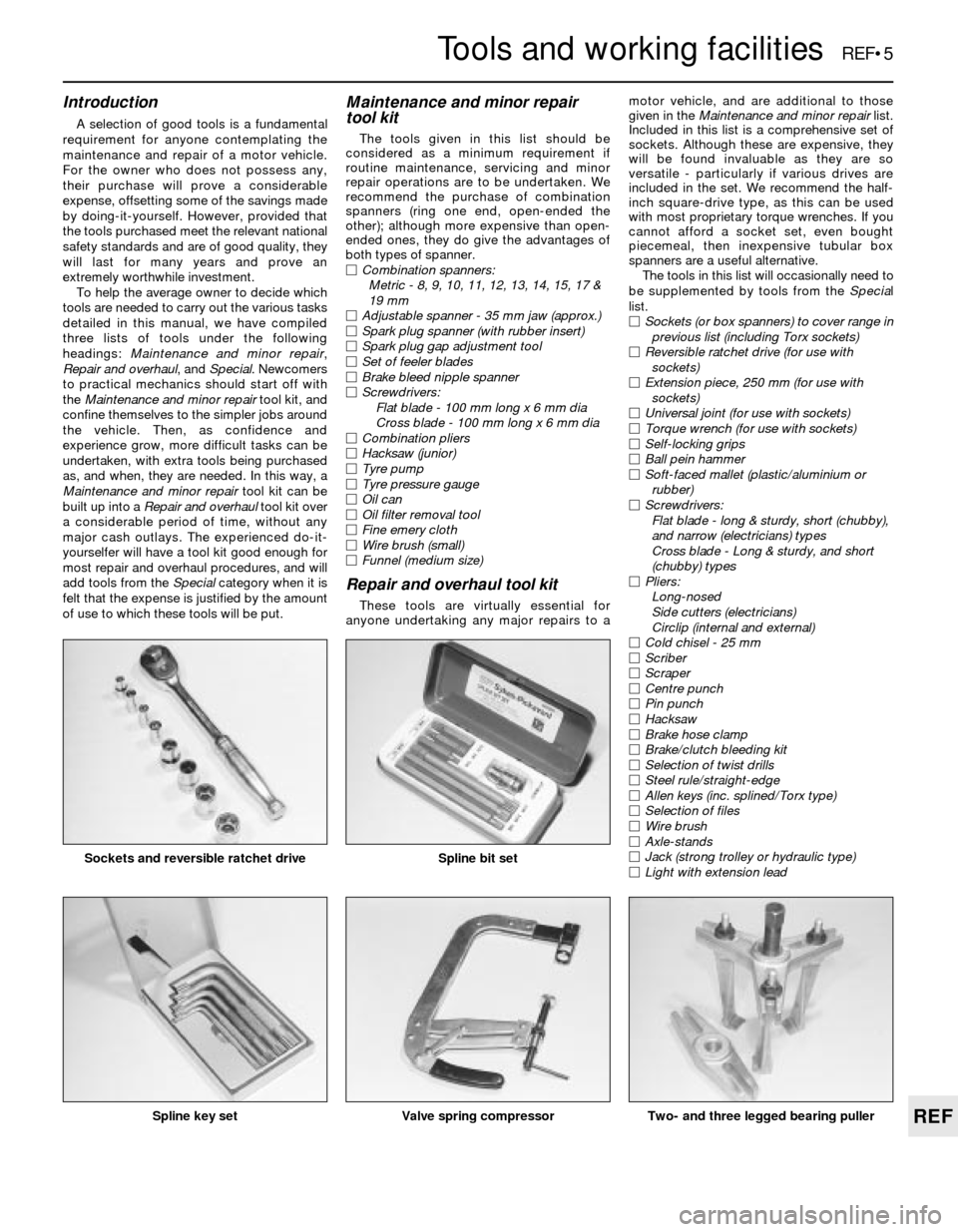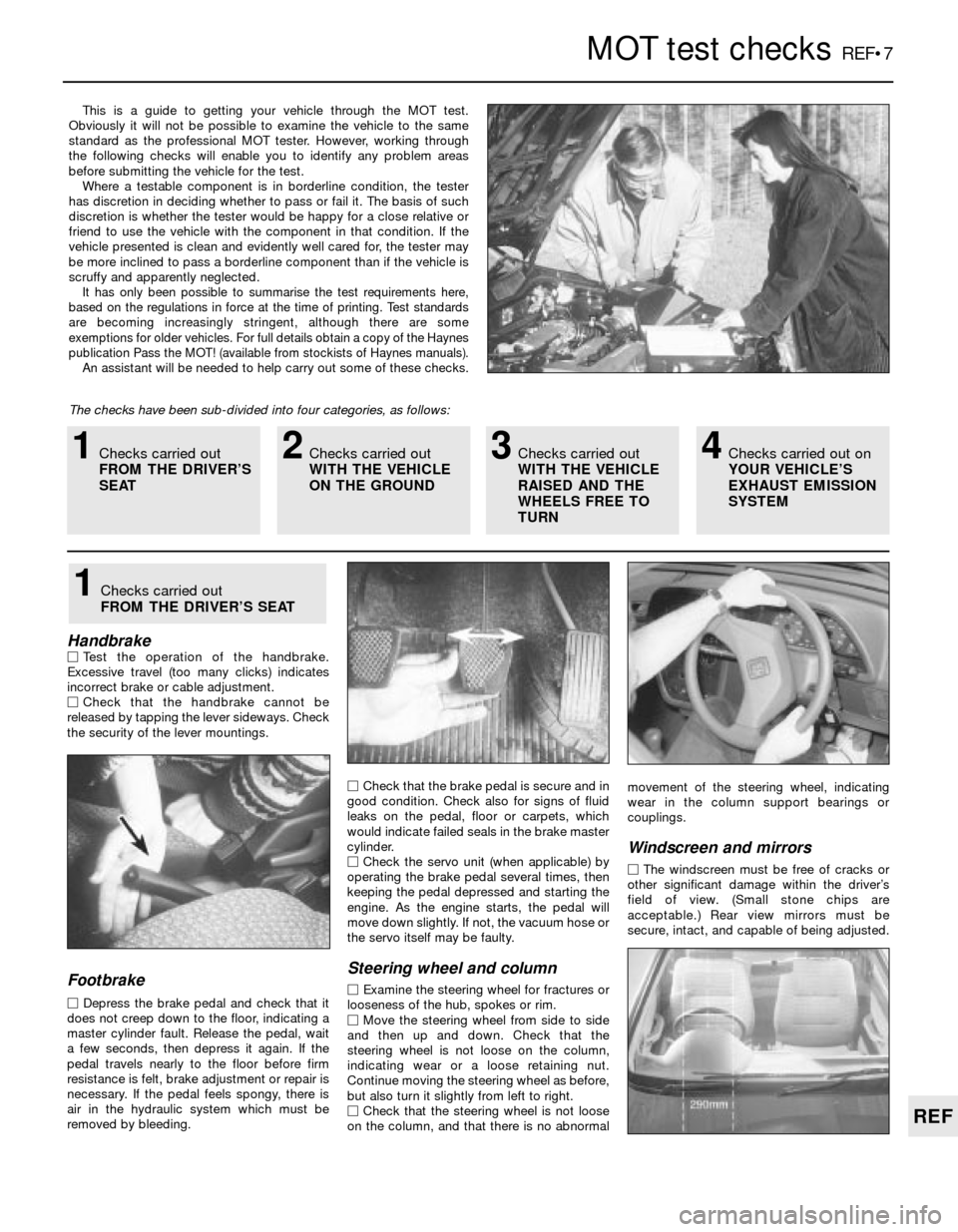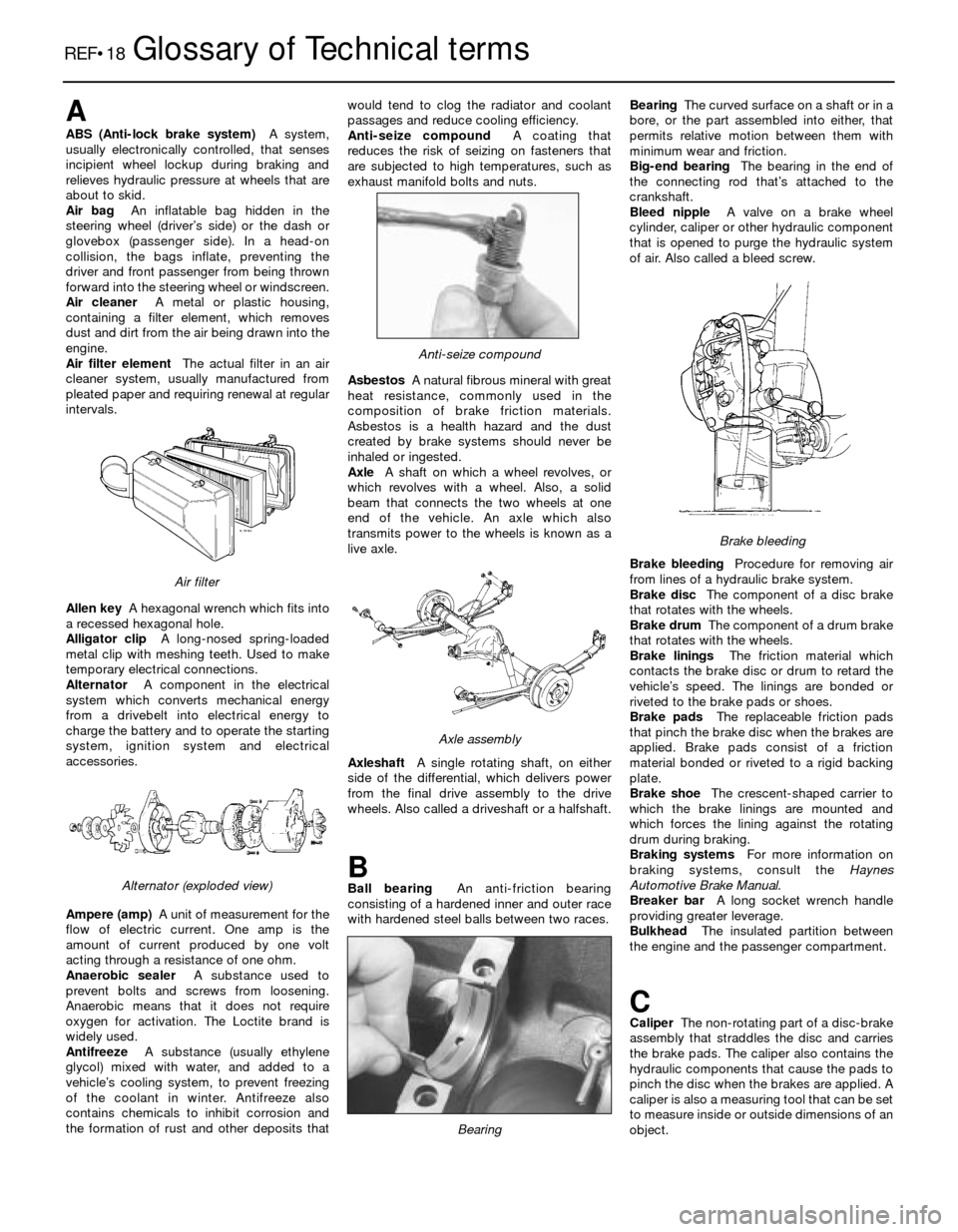air bleeding FORD SIERRA 1987 2.G Reference Workshop Manual
[x] Cancel search | Manufacturer: FORD, Model Year: 1987, Model line: SIERRA, Model: FORD SIERRA 1987 2.GPages: 26, PDF Size: 0.57 MB
Page 5 of 26

Introduction
A selection of good tools is a fundamental
requirement for anyone contemplating the
maintenance and repair of a motor vehicle.
For the owner who does not possess any,
their purchase will prove a considerable
expense, offsetting some of the savings made
by doing-it-yourself. However, provided that
the tools purchased meet the relevant national
safety standards and are of good quality, they
will last for many years and prove an
extremely worthwhile investment.
To help the average owner to decide which
tools are needed to carry out the various tasks
detailed in this manual, we have compiled
three lists of tools under the following
headings: Maintenance and minor repair,
Repair and overhaul, and Special. Newcomers
to practical mechanics should start off with
the Maintenance and minor repairtool kit, and
confine themselves to the simpler jobs around
the vehicle. Then, as confidence and
experience grow, more difficult tasks can be
undertaken, with extra tools being purchased
as, and when, they are needed. In this way, a
Maintenance and minor repairtool kit can be
built up into a Repair and overhaultool kit over
a considerable period of time, without any
major cash outlays. The experienced do-it-
yourselfer will have a tool kit good enough for
most repair and overhaul procedures, and will
add tools from the Specialcategory when it is
felt that the expense is justified by the amount
of use to which these tools will be put.
Maintenance and minor repair
tool kit
The tools given in this list should be
considered as a minimum requirement if
routine maintenance, servicing and minor
repair operations are to be undertaken. We
recommend the purchase of combination
spanners (ring one end, open-ended the
other); although more expensive than open-
ended ones, they do give the advantages of
both types of spanner.
MCombination spanners:
Metric - 8, 9, 10, 11, 12, 13, 14, 15, 17 &
19 mm
MAdjustable spanner - 35 mm jaw (approx.)
MSpark plug spanner (with rubber insert)
MSpark plug gap adjustment tool
MSet of feeler blades
MBrake bleed nipple spanner
MScrewdrivers:
Flat blade - 100 mm long x 6 mm dia
Cross blade - 100 mm long x 6 mm dia
MCombination pliers
MHacksaw (junior)
MTyre pump
MTyre pressure gauge
MOil can
MOil filter removal tool
MFine emery cloth
MWire brush (small)
MFunnel (medium size)
Repair and overhaul tool kit
These tools are virtually essential for
anyone undertaking any major repairs to amotor vehicle, and are additional to those
given in the Maintenance and minor repairlist.
Included in this list is a comprehensive set of
sockets. Although these are expensive, they
will be found invaluable as they are so
versatile - particularly if various drives are
included in the set. We recommend the half-
inch square-drive type, as this can be used
with most proprietary torque wrenches. If you
cannot afford a socket set, even bought
piecemeal, then inexpensive tubular box
spanners are a useful alternative.
The tools in this list will occasionally need to
be supplemented by tools from the Special
list.
MSockets (or box spanners) to cover range in
previous list (including Torx sockets)
MReversible ratchet drive (for use with
sockets)
MExtension piece, 250 mm (for use with
sockets)
MUniversal joint (for use with sockets)
MTorque wrench (for use with sockets)
MSelf-locking grips
MBall pein hammer
MSoft-faced mallet (plastic/aluminium or
rubber)
MScrewdrivers:
Flat blade - long & sturdy, short (chubby),
and narrow (electricians) types
Cross blade - Long & sturdy, and short
(chubby) types
MPliers:
Long-nosed
Side cutters (electricians)
Circlip (internal and external)
MCold chisel - 25 mm
MScriber
MScraper
MCentre punch
MPin punch
MHacksaw
MBrake hose clamp
MBrake/clutch bleeding kit
MSelection of twist drills
MSteel rule/straight-edge
MAllen keys (inc. splined/Torx type)
MSelection of files
MWire brush
MAxle-stands
MJack (strong trolley or hydraulic type)
MLight with extension lead
Tools and working facilities REF•5
Sockets and reversible ratchet driveSpline bit set
Spline key setValve spring compressorTwo- and three legged bearing pullerREF
Page 7 of 26

MOT test checksREF•7
REF
This is a guide to getting your vehicle through the MOT test.
Obviously it will not be possible to examine the vehicle to the same
standard as the professional MOT tester. However, working through
the following checks will enable you to identify any problem areas
before submitting the vehicle for the test.
Where a testable component is in borderline condition, the tester
has discretion in deciding whether to pass or fail it. The basis of such
discretion is whether the tester would be happy for a close relative or
friend to use the vehicle with the component in that condition. If the
vehicle presented is clean and evidently well cared for, the tester may
be more inclined to pass a borderline component than if the vehicle is
scruffy and apparently neglected.
It has only been possible to summarise the test requirements here,
based on the regulations in force at the time of printing. Test standards
are becoming increasingly stringent, although there are some
exemptions for older vehicles. For full details obtain a copy of the Haynes
publication Pass the MOT! (available from stockists of Haynes manuals).
An assistant will be needed to help carry out some of these checks.
The checks have been sub-divided into four categories, as follows:
HandbrakeMTest the operation of the handbrake.
Excessive travel (too many clicks) indicates
incorrect brake or cable adjustment.
MCheck that the handbrake cannot be
released by tapping the lever sideways. Check
the security of the lever mountings.
Footbrake
MDepress the brake pedal and check that it
does not creep down to the floor, indicating a
master cylinder fault. Release the pedal, wait
a few seconds, then depress it again. If the
pedal travels nearly to the floor before firm
resistance is felt, brake adjustment or repair is
necessary. If the pedal feels spongy, there is
air in the hydraulic system which must be
removed by bleeding.MCheck that the brake pedal is secure and in
good condition. Check also for signs of fluid
leaks on the pedal, floor or carpets, which
would indicate failed seals in the brake master
cylinder.
MCheck the servo unit (when applicable) by
operating the brake pedal several times, then
keeping the pedal depressed and starting the
engine. As the engine starts, the pedal will
move down slightly. If not, the vacuum hose or
the servo itself may be faulty.
Steering wheel and column
MExamine the steering wheel for fractures or
looseness of the hub, spokes or rim.
MMove the steering wheel from side to side
and then up and down. Check that the
steering wheel is not loose on the column,
indicating wear or a loose retaining nut.
Continue moving the steering wheel as before,
but also turn it slightly from left to right.
MCheck that the steering wheel is not loose
on the column, and that there is no abnormalmovement of the steering wheel, indicating
wear in the column support bearings or
couplings.
Windscreen and mirrors
MThe windscreen must be free of cracks or
other significant damage within the driver’s
field of view. (Small stone chips are
acceptable.) Rear view mirrors must be
secure, intact, and capable of being adjusted.
1Checks carried out
FROM THE DRIVER’S SEAT
1Checks carried out
FROM THE DRIVER’S
SEAT2Checks carried out
WITH THE VEHICLE
ON THE GROUND3Checks carried out
WITH THE VEHICLE
RAISED AND THE
WHEELS FREE TO
TURN4Checks carried out on
YOUR VEHICLE’S
EXHAUST EMISSION
SYSTEM
Page 18 of 26

REF•18Glossary of Technical terms
A
ABS (Anti-lock brake system)A system,
usually electronically controlled, that senses
incipient wheel lockup during braking and
relieves hydraulic pressure at wheels that are
about to skid.
Air bag An inflatable bag hidden in the
steering wheel (driver’s side) or the dash or
glovebox (passenger side). In a head-on
collision, the bags inflate, preventing the
driver and front passenger from being thrown
forward into the steering wheel or windscreen.
Air cleanerA metal or plastic housing,
containing a filter element, which removes
dust and dirt from the air being drawn into the
engine.
Air filter elementThe actual filter in an air
cleaner system, usually manufactured from
pleated paper and requiring renewal at regular
intervals.
Allen keyA hexagonal wrench which fits into
a recessed hexagonal hole.
Alligator clipA long-nosed spring-loaded
metal clip with meshing teeth. Used to make
temporary electrical connections.
AlternatorA component in the electrical
system which converts mechanical energy
from a drivebelt into electrical energy to
charge the battery and to operate the starting
system, ignition system and electrical
accessories.
Ampere (amp)A unit of measurement for the
flow of electric current. One amp is the
amount of current produced by one volt
acting through a resistance of one ohm.
Anaerobic sealerA substance used to
prevent bolts and screws from loosening.
Anaerobic means that it does not require
oxygen for activation. The Loctite brand is
widely used.
AntifreezeA substance (usually ethylene
glycol) mixed with water, and added to a
vehicle’s cooling system, to prevent freezing
of the coolant in winter. Antifreeze also
contains chemicals to inhibit corrosion and
the formation of rust and other deposits thatwould tend to clog the radiator and coolant
passages and reduce cooling efficiency.
Anti-seize compoundA coating that
reduces the risk of seizing on fasteners that
are subjected to high temperatures, such as
exhaust manifold bolts and nuts.
AsbestosA natural fibrous mineral with great
heat resistance, commonly used in the
composition of brake friction materials.
Asbestos is a health hazard and the dust
created by brake systems should never be
inhaled or ingested.
AxleA shaft on which a wheel revolves, or
which revolves with a wheel. Also, a solid
beam that connects the two wheels at one
end of the vehicle. An axle which also
transmits power to the wheels is known as a
live axle.
AxleshaftA single rotating shaft, on either
side of the differential, which delivers power
from the final drive assembly to the drive
wheels. Also called a driveshaft or a halfshaft.
BBall bearingAn anti-friction bearing
consisting of a hardened inner and outer race
with hardened steel balls between two races.BearingThe curved surface on a shaft or in a
bore, or the part assembled into either, that
permits relative motion between them with
minimum wear and friction.
Big-end bearingThe bearing in the end of
the connecting rod that’s attached to the
crankshaft.
Bleed nippleA valve on a brake wheel
cylinder, caliper or other hydraulic component
that is opened to purge the hydraulic system
of air. Also called a bleed screw.
Brake bleedingProcedure for removing air
from lines of a hydraulic brake system.
Brake discThe component of a disc brake
that rotates with the wheels.
Brake drumThe component of a drum brake
that rotates with the wheels.
Brake liningsThe friction material which
contacts the brake disc or drum to retard the
vehicle’s speed. The linings are bonded or
riveted to the brake pads or shoes.
Brake padsThe replaceable friction pads
that pinch the brake disc when the brakes are
applied. Brake pads consist of a friction
material bonded or riveted to a rigid backing
plate.
Brake shoeThe crescent-shaped carrier to
which the brake linings are mounted and
which forces the lining against the rotating
drum during braking.
Braking systemsFor more information on
braking systems, consult the Haynes
Automotive Brake Manual.
Breaker barA long socket wrench handle
providing greater leverage.
BulkheadThe insulated partition between
the engine and the passenger compartment.
CCaliperThe non-rotating part of a disc-brake
assembly that straddles the disc and carries
the brake pads. The caliper also contains the
hydraulic components that cause the pads to
pinch the disc when the brakes are applied. A
caliper is also a measuring tool that can be set
to measure inside or outside dimensions of an
object.
Brake bleeding
Bearing
Axle assembly
Anti-seize compound
Alternator (exploded view)
Air filter
Page 23 of 26

AAccelerator cable- 4A•8
Accelerator pedal- 4A•8
Acknowledgements- 0•4
Aerial- 13•20
Air cleaner- 1•18, 1•19, 4A•4, 4B•4
Air conditioning systems- 1•16, 3•1 et seq
Airflow meter- 4B•8
Alarm system- 13•19
Alternator- 5•6
Anti-roll bars- 11•6, 11•13
Anti-theft alarm- 13•19
Antifreeze- 0•17, 1•21, 3•3
ATF- 0•17, 1•3
Automatic transmission- 7B•1 et seq
extension housing oil seal - 7B•5
fault diagnosis - REF•11, REF•14
fluid - 0•17, 1•3
fluid checks - 1•13
gear selector mechanism - 7B•5
kickdown cable - 7B•3
removal and refitting - 7B•2
reversing lamp switch - 7B•6
selector rod - 7B•5
starter inhibitor switch - 7B•6
vacuum diaphragm unit - 7B•6
Auxiliary drivebelts- 1•14, 1•21
Auxiliary shaft- 2A•18
BBattery- 0•15, 1•15, 5•5
Bearings (engine) - 2A•23, 2B•17, 2C•23
Bleeding the power steering- 11•18
Bleeding the brakes- 10•2
Body damage- 12•2, 12•4
Body electrical systems - 13•1 et seq
Bodywork and fittings- 12•1 et seq
Bonnet release cable- 12•4
Bonnet lock- 12•4, 12•5
Boot lid lock- 12•5
Brake checks- 1•10
Brake fluid- 0•13, 0•1, 1•21
Braking system- 10•1 et seq
backplate - 10•12
bleeding the brakes - 10•2
brake caliper - 10•8, 10•10
brake disc - 10•3, 10•11
brake drum - 10•12
brake fluid pipes and hoses - 10•19
brake fluid reservoir - 10•15
brake lamp switch - 13•6
brake pads - 10•3
brake pedal - 10•22
brake shoes - 10•6
computer module (ABS) - 10•17
deceleration valve - 10•18
fault diagnosis - REF•11, REF•15
handbrake adjustment - 1•16, 10•20, 10•21
handbrake cables - 1•16, 10•20, 10•21
handbrake lever - 10•22
hoses brake - 10•19
hydraulic unit pressure switch - 10•17
hydraulic unit/pump/motor (ABS) - 10•15, 10•16
load apportioning valve - 10•19master cylinder (brake) - 10•13
pressure switch - 10•17
vacuum servo unit - 10•14
valve block (ABS) - 10•17
wheel cylinder - 10•12
wheel sensor - 10•18
Bulbs exterior- 13•16
Bulbs interior- 13•10
Bulbs ratings- 13•2
Bumpers- 12•13
Buying spare parts - REF•3
CCables:
accelerator - 4A•8
bonnet release - 12•4
clutch - 6•2
handbrake - 10•20, 10•21
kickdown - 7B•3
speedometer - 13•11
tailgate/boot lid/filler cap - 12•6
Caliper (brake) front/rear- 10•8, 10•10
Camshaft and followers- 2A•17, 2B•14, 2C•16
Capacities- 1•3
Carburettor:
Ford VV type - 1•12, 4A•8, 4A•13
Pierburg 2V type - 1•12, 4A•8, 4A•14
Weber 2V type - 1•12, 4A•8, 4A•14
Weber 2V TLD type - 1•12, 4A•8, 4A•15
Cargo area- 12•10
Carpets- 12•2
Catalytic converter- 4B•3, 4B•14
Central locking system- 13•18
Centre/overhead console- 12•18, 12•19
CFI unit- 4B•10
Charging system- 5•5
Cigarette lighter- 13•6
Clock- 13•6
Clutch- 6•1 et seq
assembly - 6•3
cable - 6•2
fault diagnosis - REF•11, REF•14
pedal - 6•2
release bearing - 6•5
Coil- 5•13
Coil spring (rear) - 11•10
Compression test- 2A•7
Computer module (ABS)- 10•17
Connecting rods- 2A•22, 2B•17, 2C•21
Contents- 0•2
Coolant- 0•12, 0•17, 1•21, 3•3
Coolant level- 0•12
Cooling, heating and air conditioning
systems- 3•1 et seq
antifreeze - 0•12, 0•17, 1•21, 3•3
coolant pump - 3•5
coolant temperature sender and sensor - 3•8
cooling fan - 3•7
draining - 1•21
drivebelt tensioner - 3•7
expansion tank/coolant sensor - 3•8
fan (radiator) - 3•7
fault diagnosis - REF•11, REF•13
filling - 1•21
flushing - 1•21heater - 3•9
radiator - 3•3
switches - 3•8
temperature gauge and sender unit - 3•8
thermostat - 3•4
Courtesy lamp switch- 13•5
Crankshaft oil seals- 2A•19, 2B•15, 2C•19
Crankshaft bearings- 2A•23, 2B•17, 2C•23
Cylinder bores- 2A•24
Cylinder head- 2A•14, 2B•10, 2C•13
DDents- 12•2
Depressurising fuel injection system- 4B•4
Dimensions and weights- REF•1
Disc brake - 10•3, 10•11
Distributor- 5•14, 5•15, 5•16
Door- 12•6
Door inner trim panel- 12•7
Door mirror switch- 13•5
Drivebelts check- 1•14, 1•21, 3•7
Driveplate- 2A•18, 2B•15, 2C•19
Driveshafts:
check - 1•17
fault diagnosis - REF•11, REF•15
overhaul - 9•5
removal and refitting - 9•4
Drum (brake)- 10•12
EEarth fault finding- 13•3
Electric windows- 13•18
Electrical fault finding- 13•2
Electrical system (body)- 13•1 et seq
Electrical system:
weekly checks - 0•14
fault diagnosis - REF•11, REF•16
Electronic vacuum regulator- 4B•11
Engine:
auxiliary shaft - 2A•18
bearings - 2A•23, 2B•17, 2C•23
bores - 2A•24
camshaft followers - 2A•17, 2B•14, 2C•16
codes - 2A•1, 2B•1, 2C•1
compartment views - 0•10, 1•5
compression test - 2A•7
connecting rods - 2A•22, 2B•17, 2C•21
crankshaft bearings - 2A•23, 2B•17, 2C•23
crankshaft oil seals - 2A•19, 2B•15, 2C•19
cylinder bores - 2A•24
cylinder head - 2A•14, 2B•10, 2C•13
dismantling - 2A•11, 2B•8, 2C•10
DOHC engines- 2B•1 et seq
driveplate - 2A•18, 2B•15, 2C•19
fault diagnosis - REF•11, REF•12
flywheel - 2A•18, 2B•15, 2C•19
main bearings - 2A•23, 2B•17, 2C•23
mountings - 2A•11, 2B•7, 2C•9
oils - 0•17, 1•3
oil and filter renewal - 1•9
oil level - 0•12
oil pump - 2A•21, 2B•16, 2C•20
oil seals crankshaft - 2A•19, 2B•15, 2C•19
piston - 2A•22, 2B•17, 2C•21
IndexREF•23
REF
Note: References throughout this index are in the form - “Chapter number” • “page number”
Page 24 of 26

refitting - 2A•10, 2B•7, 2C•9
removal - 2A•8, 2B•4, 2C•6
SOHC engines- 2A•1et seq
spark plugs - 1•2, 1•14, 5•12
sump - 2A•20, 2B•15, 2C•19
timing belt/chain and sprockets - 2A•12,
2B•8, 2C•10
timing and sprockets - 2A•12, 2B•8, 2C•10
valves - 1•15
Engine electrical systems - 5•1 et seq
Environmental considerations- REF•4
Exhaust gas oxygen sensor (HEGO)- 4B•15
Exhaust gas recirculation valve- 4B•14
Exhaust manifold- 4A•17, 4B•15
Exhaust pressure transducer- 4B•14
Exhaust system- 1•11, 4A•18, 4B•15
Expansion tank/coolant sensor- 3•8
FFacia panel- 12•16
Facia panel switches- 13•4
Fan (radiator)- 3•7
Fault diagnosis- REF•11
automatic transmission - REF•14
braking system - REF•15
clutch - REF•14
cooling system - REF•13
driveshafts - REF•15
electrical system - REF•16
engine - REF•12
final drive - REF•15
fuel and exhaust systems - REF•13
manual gearbox - REF•14
propeller shaft - REF•15
steering - REF•16
suspension - REF•16
Final drive and driveshafts- 9•1 et seq
Final drive fault diagnosis- REF•11, REF•15
Final drive unit- 9•2, 9•3, 9•4
Fluids- 0•17
Flywheel/driveplate- 2A•18, 2B•15, 2C•19
Foglamps- 13•15
Ford VV carburettor- 1•12, 4A•13
Front suspension crossmember- 11•3
Front suspension strut- 11•4
Fuel systems- carburettor - 4A•1 et seq
Fuel systems- fuel injection - 4B•1 et seq
Fuel system:
accelerator cable - 4A•8
accelerator pedal - 4A•8
air cleaner - 1•18, 1•19, 4A•4, 4B•4
airflow meter - 4B•8
catalytic converter - 4B•3, 4B•14
CFI unit- 4B•10
depressurising fuel injection system - 4B•4
dismantling and reassembly - 4A•8
electronic vacuum regulator - 4B•11
exhaust gas recirculation valve - 4B•14
exhaust gas oxygen sensor (HEGO) - 4B•15
exhaust manifold - 4A•17, 4B•15
exhaust pressure transducer - 4B•14
exhaust system - 4A•18, 4B•15
fuel filler cap - 12•14
fuel filter - 1•2, 1•20
fuel level sender unit - 4A•7, 4B•7fuel pressure regulator - 4A•5, 4B•5
fuel pump - 4A•5, 4A•6, 4B•6
fuel tank - 4A•7
fuel vapour separator - 4A•5
fuel gauges - 13•8
idle speed control valve - 4B•7
injector(s) - 4B•8
inlet manifold - 4A•15, 4B•12
mixture adjustment potentiometer - 4B•7
pulse-air - 4B•10
throttle body - 4B•12
throttle control motor - 4B•11
throttle position sensor - 4B•11
throttle valve control motor - 4B•11
Fuses- 13•3
GGear linkage- 7A•4
Gear selector mechanism- 7B•5
Gearbox - see Manual gearbox or
Automatic transmission
Gearbox oil- 0•17, 1•3
Glass- 12•11
HHandbrake check/adjustment- 1•16, 10•21
Handbrake cables- 10•20, 10•21
Handbrake lever - 10•22
Handbrake warning lamp switch- 13•6
Handles (door)- 12•9
Hazard warning flasher switch- 13•4
Headlamp alignment- 13•14
Headlamp unit- 13•13
Headlamp washers- 13•12
Headlining - 12•19
Heated rear window- 13•20
Heated seat- 13•19
Heater- 3•9
Hinges and locks- 1•14
Horn- 13•11
Horn switch- 13•5
Hose and fluid leak check- 0•8, 1•10,
Hoses brake- 10•19
Hoses power steering- 11•18
HT coil- 5•13
HT leads- 5•12
Hub carrier (front) - 11•5
Hydraulic fluid- 0•17
Hydraulic system (brakes) bleeding- 10•2
Hydraulic unit, pump, motor (ABS)- 10•15,
10•16
IIdle speed control valve- 4B•7
Idle speed/mixture- 1•11, 1•12, see
Specifications in Chapter 4A, and refer to
specific carburettor type
Ignition electronic modules- 5•3, 5•19
Ignition HT coil- 5•13
Ignition switch- 13•4
Ignition system check- 1•20
Ignition timing adjustment- 5•17
Indicator lamps- 13•15Indicator switch/relay- 13•4
Injector(s)- 4B•8
Inlet manifold- 4A•15, 4B•12
Instrument panel- 13•7
Interior trim- 12•15
Introduction to the Ford Sierra- 0•4
JJacking and vehicle support- 0•6
Jump starting- 0•9
KKickdown cable - 7B•3
LLeaf springs- 11•13
Leak, checking- 0•8, 1•10
Lights- 13•14
Locks:
bootlid - 12•5
door - 12•9, 12•10
tailgate - 12•6
Loudspeakers- 13•20
Lower arm (suspension)- 11•4, 11•7, 11•8
Lubricants and fluids- 0•17
Luggage area light switch- 13•5
MMain bearings- 2A•23, 2B•17, 2C•23
Maintenance and servicing - see Routine
maintenance
Manifolds- 4A•15, 4A•17, 4B•12, 4B•15
Manual gearbox- 7A•1 et seq
fault diagnosis - REF•11, REF•14
gear linkage - 7A•4
gearbox oil - 0•17, 1•3
oil level check - 1•13
removal and refitting - 7A•2
Master cylinder (brake)- 10•13
Mirrors- 12•12
Mixture (CO)- see Idle speed/mixture
Mixture adjustment potentiometer- 4B•7
MOT test checks- REF•7
Mountings, engine-2A•11, 2B•7, 2C•9
NNumber plate lamp- 13•16
OOil change/filter- 1•1, 1•9,
Oil pressure warning switch- 13•6
Oil pump- 2A•21, 2B•16, 2C•20
Oil seals- REF •4
Oil seals crankshaft- 2A•19, 2B•15, 2C•19
Oils- engine and gearbox- 0•17, 1•3
PPads (brake) - 10•3
Paintwork damage- 12•2
Parts- REF•3
REF•24Index
Page 25 of 26

Pedals:
accelerator - 4A•8
brake - 10•22
clutch - 6•2
Pierburg 2V carburettor- 1•12, 4A•14
Pipes/hoses (braking system)- 10•19
Pistons- 2A•22, 2B•17, 2C•21
Plastic components- 12•3
Plugs- 1•2, 1•14, 5•12
Power operated windows- 13•18
Power steering fluid- 0•17
Power steering fluid level- 0•14
Power steering fluid hoses-11•18
Power steering pump- 11•18
Power steering system bleeding- 11•18
Pressure switch (hydraulic unit)- 10•17
Propeller shaft- 8•1 et seq
centre bearing - 8•2
fault diagnosis - REF•11, REF•15
front rubber coupling - 8•3
removal and refitting - 8•2
vibration damper - 8•4
Pulse-air system- 4B•10
Punctures- 0•6
RRadiator- 1•16, 3•3
Radiator cooling fan- 3•7
Radiator grille- 12•14
Radio/cassette player- 13•21
Rear axle- 9•7, 9•8, 11•13
Relays- 13•3
Release bearing (clutch)- 6•5
Repair procedures- REF •4
Respraying- 12•2
Reversing lamp switch- 7B•6, 13•4
Roadtest- 1•17
Roadwheel check- 1•11
Roll bars- 11•6, 11•13
Rotor arm- 5•14, 5•15
Routine maintenance and servicing- 1•1 et seq
Routine maintenance procedures- 1•9
Routine maintenance schedule- 1•3
SSafety first!- 0•5
Scratches- 12•2
Seat belts- 1•11, 12•21
Seat heating pad- 13•19
Seats- 12•19
Selector rod- 7B•5
Sender unit fuel level- 4A•7, 4B•7
Sender units coolant temperature- 3•8
Servicing -see Routine maintenance
Servo unit (braking system)- 10•14
Shock absorber- 11•9
Shoes (brake)- 10•6
Short-circuit finding- 13•3
Spare parts- REF•3
Spark plugs- 1•2, 1•14, 5•12
Speakers- 13•20Specifications- see start of relevant Chapter
Speedometer- 13•8
Speedometer cable- 13•11
Spoiler- 12•6
Starter inhibitor switch- 7B•6
Starter motor- 5•8
Steering- 11•1 et seq
check -1•17, 1•18
column/adjustment - 11•15
fault diagnosis - REF•11, REF•16
gear - 11•16, 11•18
hoses - 11•18
power steering system bleeding - 11•18
pump - 11•18
tie-rod end - 11•18
wheel - 11•14
wheel alignment - 11•1, 11•19
Sump- 2A•20, 2B•15, 2C•19
Sunroof- 12•15, 13•6
Support struts (tailgate)- 12•6
Suspension and steering- 11•1 et seq
anti-roll bars - 11•6, 11•13
check - 1•17, 1•18
coil spring (rear) - 11•10
crossmember (front) - 11•3
fault diagnosis - REF•11, REF•16
hub carrier (front) - 11•5
leaf springs - 11•13
lower arm (front/rear) - 11•4, 11•7, 11•8
mountings - 11•12
rear axle assembly - 11•13
shock absorber - 11•9
strut (front) - 11•4
wheel bearings - 11•6, 11•10
Switches:
brake lamp - 13•6
cooling system - 3•8
courtesy lamp - 13•5
direction indicator - 13•4
electric door mirror - 13•5
facia panel - 13•4
handbrake warning lamp - 13•6
hazard warning lamp - 13•4
horn - 13•5
hydraulic pressure (brakes) - 10•17
ignition/lockbarrel - 13•4
luggage area light - 13•5
oil pressure warning - 13•6
reversing - 7B•6, 13•4
starter inhibitor - 7B•6
TTachometer- 13•8
Tailboard- 12•11
Tailgate struts- 12•6
Tailgate/lock- 12•5, 12•6
Temperature gauge and sender unit- 3•8
Thermostat- 3•4
Throttle body- 4B•12
Throttle cable- 4A•8
Throttle position sensor- 4B•11
Throttle valve control motor- 4B•11Tie-rod end- 11•18
Timing adjustment- 5•17
Timing belt/chain and sprockets- 2A•12,
2B•8, 2C•10
Tools and working facilities- REF•5
Towing- 0•7
Transmission housing oil seal- 7B•5
Trim panel (door)- 12•7
Tyre checks and pressures- 0•16, 0•18
UUnderbody- 1•7 1•8, 1•17, 12•2
Underbonnet views -0•10, 1•5
Unleaded petrol- 5•18
Upholstery and carpets- 12•2
VVacuum diaphragm unit- 7B•6
Vacuum servo unit (braking system)- 10•14
Valve block (ABS)- 10•17
Valves- 1•15
Vehicle identification numbers- REF•3
Ventilation system- 3•1 et seq
WWarning system components- 13•9
Washer fluid level- 0•13
Washers- 13•12
Weatherstrip- 12•15
Weber 2V carburettor- 1•12, 4A•14
Weber 2V TLD carburettor- 1•12, 4A•15
Weekly checks- 0•10
Wheel (steering) - 11•14
Wheel alignment- 11•1, 11•19
Wheel arch liners- 12•14
Wheel bearings- 11•6, 11•10
Wheel changing- 0•6
Wheel cylinder- 10•12
Wheel sensor(ABS)- 10•18
Window glass- 12•11
Window regulator- 12•12
Windscreen- 12•11, 12•14
Windscreen washers- 13•12
Windscreen wiper motor- 13•12
Wiper arms- 13•11
Wiper blades- 0•15, 13•11
Wiper motor (headlamp)- 13•13
Wiper motor (rear)- 13•12
Wiper motor (windscreen)- 13•12
Wiring diagrams- WD•1 et seq
Working facilities- REF•5
IndexREF•25
REF